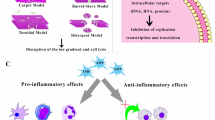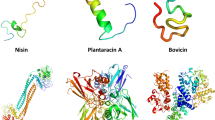Abstract
There is considerable current interest in developing antimicrobial and anticancer agents with a new mode of action. The antimicrobial peptides are regarded as a potential solution for treating cancer cells. The antimicrobial effect of 6 synthetic peptides against 7 bacterial species was evaluated. The result showed that IsCT, BmKn2 and BMAP-28 exhibited broad range of action against Bacillus subtilis ATCC 6633, Staphylococcus aureus ATCC 6538, methicillin resistant S. aureus DMST 20651, Staphylococcus epidermidis ATCC 12228, Acinetobacter baumanii ATCC 19066, Escherichia coli ATCC 25922 and Salmonella typhi DMST 562 at minimal inhibitory concentrations (MIC) of 2.97–24.28 μM. Neither AMP induced significant hemolysis, or showed cytotoxic on dental pulp stem cells and smooth muscle cells at their MICs. In addition, BmKn2 inhibited growth of human oral squamous carcinoma HSC4 cells and human colon cancer SW620 cells with IC50 of 17.26 and 40 µM, respectively. Taken together, BmKn2 peptide from scorpion venom may offer a novel therapeutic strategy for development of cationic antimicrobial and anticancer peptides as potential new therapeutic agents.

Similar content being viewed by others
References
Arpornsuwan T, Punjanon T (2006) Tumor cell-selective antiproliferative effect of the extract from Morinda citrifolia fruits. Phytother Res 20:515–517
Ausbacher D, Svineng G, Hansen T, Strøm MB (2012) Anticancer mechanisms of action of two small amphipathic β(2,2)-amino acid derivatives derived from antimicrobial peptides. Biochim Biophys Acta 1818:2917–2925
Benincasa M, Skerlavaj B, Gennaro R, Pellegrini A, Zanetti M (2003) In vitro and in vivo antimicrobial activity of two alpha-helical cathelicidin peptides and of their synthetic analogs. Peptides 24:1723–1731
Cao L, Dai C, Li Z, Fan Z, Song Y, Wu Y, Cao Z, Li W (2012) Antimicrobial activity and mechanism of a scorpion venom peptide derivative in vitro and in vivo. PLoS One 7:e40135
Chan YR, Gallo RL (1998) PR-39, a syndecan-inducing antimicrobial peptide, binds and affects p130Cas. J Biol Chem 273:28978e85
Chen Y, Guarnieri MT, Vasil AI, Vasil ML, Mant CT, Hodges RS (2007) Role of peptide hydrophobicity in the mechanism of action of α-helical antimicrobial peptides. Antimicrob Agents Chemother 51:1398–1406
Chiu D, Lubin B, Shohet SB (1979) Erythrocyte membrane lipid reorganization during the sickling process. Br J Haematol 41:223–234
Dai C, Ma Y, Zhao Z, Zhao R, Wang Q, Wu Y, Cao Z, Li W (2008) Mucroporin, the first cationic host defense peptide from the venom of Lychas mucronatus. Antimicrob Agents Chemother 52:3967–3972
Dathe M, Nikolenko H, Meyer J, Beyermann M, Bienert M (2001) Optimization of the antimicrobial activity of magainin peptides by modification of charge. FEBS Lett 501:146–150
De Kroon AI, Soekarjo MW, De Gier J, De Kruijff B (1990) The role of charge and hydrophobicity in peptide-lipid interaction: a comparative study based on tryptophan fluorescence measurements combined with the use of aqueous and hydrophobic quenchers. Biochemistry 29:8229–8240
Dobrzynska J, Szachowicz-Petelska B, Sulkowski S, Figaszewski Z (2005) Changes in electric charge and phospholipids composition in human colorectal cancer cells. Mol Cell Biochem 276:113–119
Fernandez DI, Gehman JD, Separovic F (2009) Membrane interactions of antimicrobial peptides from Australian frogs. Biochim Biophys Acta 1788:1630–1638
Gaspar D, Veiga AS, Castanho MA (2013) From antimicrobial to anticancer peptides. Rev Front Microbiol 4:294
Gatti L, Zunino F (2005) Overview of tumor cell chemoresistance mechanisms. Methods Mol Med 111:127–148
Gautier R, Douguet D, Antonny B, Drin G (2008) HELIQUEST: a web server to screen sequences with specific alpha-helical properties. Bioinformatics 24:2101–2102
Giuliani A, Pirri G, Bozzi A, Di Giulio A, Aschi M, Rinaldi AC (2008) Antimicrobial peptides: natural templates for synthetic membrane-active compounds. Cell Mol Life Sci 65:2450–2460
Gross S, Andra J (2012) Anticancer peptide NK-2 targets cell surface sulphated glycans rather than sialic acids. Biol Chem 393:817–827
Guiliani A, Pirri G, Nicoletto SF (2007) Antimicrobial peptides: an overview of a promising class of therapeutics. Cent Eur J Biol 2:1–33
Hancock REW, Sahl H-G (2006) Antimicrobial and host-defense peptides as new anti-infective therapeutic strategies. Nat Biotechnol 24:1551–1557
Hoskin DW, Ramamoorthy A (2008) Studies on anticancer activities of antimicrobial peptides. Biochim Biophys Acta 1778:357–375
Kamath L, Meydani A, Foss F, Kuliopulos A (2001) Signaling from protease-activated receptor-1 inhibits migration and invasion of breast cancer cells. Cancer Res 61:5933–5940
Khandelia H, Ipsen JH, Mouritsen OG (2008) The impact of peptides on lipid membranes. Biochim Biophys Acta 1778:1528–1536
Koszałka P, Kamysz E, Wejda M, Kamysz W, Bigda J (2011) Antitumor activity of antimicrobial peptides against U937 histiocytic cell line. Acta Biochim Pol 58:111–117
Langfield RD, Scarano FJ, Heitzman ME, Kondo M, Hammond GB, Neto CC (2004) Use of a modified microplate bioassay method to investigate antimicrobial activity in the Peruvian medicinal plant Peperomia galioides. J Ethnopharmacol 94:279–281
Lee K, Shin SY, Kim K, Lim SS, Hahm KS, Kim Y (2004) Antibiotic activity and structural analysis of the scorpion-derived antimicrobial peptide IsCT and its analogs. Biochem Biophys Res Commun 323:712–719
Leptihn S, Har JY, Wohland T, Ding JL (2010) Correlation of charge, hydrophobicity, and structure with antimicrobial activity of S1 and MIRIAM peptides. Biochemistry 49:9161–9170
Liang J, Adamian L, Jackups R Jr (2005) The membrane–water interface region of membrane proteins: structural bias and the anti-snorkeling effect. Trends Biochem Sci 30:355–357
Lu Y, Li J, Yu H, Xu X, Liang J, Tian Y, Ma D, Lin G, Huang G, Lai R (2006) Two families of antimicrobial peptides with multiple functions from skin of rufous-spotted torrent frog, Amolops loloensis. Peptides 27:3085–3091
Makovitski A, Baram J, Shai Y (2008) Antimicrobial lipopolypeptides composed of palmitoyl di- and tricationic peptides: in vitro and in vivo activities, selfassembly to nanostructures, and a plausible mode of action. Biochemistry 47:10630–10636
Malina A, Shai Y (2005) Conjugation of fatty acids with different lengths modulates the antimicrobial and antifungal activity of a cationic biologically inactive peptide. Biochem J 390:695–702
Papo N, Shai Y (2003) New lytic peptides based on the d, l-amhipathic helix motif preferentially kill tumor cells compared to normal cells. Biochemistry 42:9346–9354
Paredes-Gamero EJ, Martins MN, Cappabianco FA, Ide JS, Miranda A (2012) Characterization of dual effects induced by antimicrobial peptides: regulated cell death or membrane disruption. Biochim Biophys Acta 1820:1062–1072
Park CB, Yi K-S, Matsuzaki K, Kim MS, Kim SC (2000) Structure-activity analysis of buforin II, a histone H2A-derived antimicrobial peptide: the proline hinge is responsible for the cell-penetrating ability of buforin II. Proc Natl Acad Sci USA 97:8245–8250
Pasupuleti M, Schmidtchen A, Malmsten M (2012) Antimicrobial peptides: key components of the innate immune system. Crit Rev Biotechnol 32:143–171
Risso A, Zanetti M, Gennaro R (1998) Cytotoxicity and apoptosis mediated by two peptides of innate immunity. Cell Immunol 189:107–115
Risso A, Braidot E, Sordano MC, Vianello A, Macrì F, Skerlavaj B, Zanetti M, Gennaro R, Bernardi P (2002) BMAP-28, an antibiotic peptide of innate immunity, induces cell death through opening of the mitochondrial permeability transition pore. Mol Cell Biol 22:1926–1935
Rost B, Sander C (1993) Prediction of protein secondary structure at better than 70 % accuracy. J Mol Biol 232:584–599
Sapay N, Guermeur Y, Deleage G (2006) Prediction of amphipathic in-plane membrane anchors in monotopic proteins using a SVM classifier. BMC Bioinform 7:255
Skerlavaj B, Gennaro R, Bagella L, Merluzzi L, Risso A, Zanetti M (1996) Biological characterization of two novel cathelicidin-derived peptides and identification of structural requirements for their antimicrobial and cell lytic activities. J Biol Chem 271:28375–28381
Tanaka K, Fujimoto Y, Suzuki M, Suzuki Y, Ohtake T, Saito H et al (2001) PI3-kinase p85a is a target molecule of proline-rich antimicrobial peptide to suppress proliferation of ras-transformed cells. Jpn J Cancer Res 92:959–967
Wang M, Wang Y, Wang A, Song Y, Ma D, Yang H, Ma Y, Lai R (2010) Five novel antimicrobial peptides from skin secretions of the frog, Amolops loloensis. Comp Biochem Physiol B 155:72–76
Wieprecht T, Dathe M, Beyermann M, Krause E, Maloy WL, MacDonald DL, Bienert M (1997) Peptide hydrophobicity controls the activity and selectivity of magainin 2 amide in interaction with membranes. Biochemistry 36:6124–6132
Xu X, Yang H, Yu H, Li J, Lai R (2006) The mastoparanogen from wasp. Peptides 27:3053–3057
Yamada Y, Shinohara Y, Kakudo T, Chaki S, Futaki S, Kamiya H, Harashima H (2005) Mitochondrial delivery of mastoparan with transferrin liposomes equipped with a pH-sensitive fusogenic peptide for selective cancer therapy. Int J Pharma 303:1–7
Zasloff M (2002) Antimicrobial peptides of multicellular organisms. Nature 415:389–395
Zeng XC, Wang SX, Zhu Y, Zhu SY, Li WX (2004) Identification and functional characterization of novel scorpion venom peptides with no disulfide bridge from Buthus martensii Karsch. Peptides 25:143–150
Acknowledgments
We would like to thank TU Research grant supported by Thammasat University for the financial support to this study. Thanks are also extended to Faculty of Science, Ramkhamhaeng University and Faculty of Dentist, Mahidol University for kind supports in providing SW620 cell line, oral cancer cell line and dental pulp stem cells.
Conflict of interest
None.
Author information
Authors and Affiliations
Corresponding author
Rights and permissions
About this article
Cite this article
Arpornsuwan, T., Sriwai, W., Jaresitthikunchai, J. et al. Anticancer Activities of Antimicrobial BmKn2 Peptides Against Oral and Colon Cancer Cells. Int J Pept Res Ther 20, 501–509 (2014). https://doi.org/10.1007/s10989-014-9417-9
Accepted:
Published:
Issue Date:
DOI: https://doi.org/10.1007/s10989-014-9417-9




